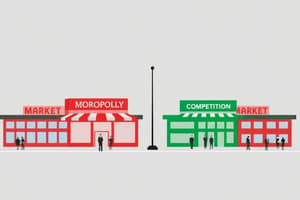Podcast
Questions and Answers
Which of the following is a characteristic of a monopoly?
Which of the following is a characteristic of a monopoly?
- Identical products
- Single seller (correct)
- Many sellers
- Free entry and exit
In perfect competition, firms are considered to be:
In perfect competition, firms are considered to be:
- Price controllers
- Price regulators
- Price makers
- Price takers (correct)
What is the main source of a monopoly's market power?
What is the main source of a monopoly's market power?
- Barriers to entry (correct)
- High competition
- Product differentiation
- Government subsidies
In the long run, firms in perfect competition earn:
In the long run, firms in perfect competition earn:
Which of the following is NOT true for a monopolist?
Which of the following is NOT true for a monopolist?
A monopolist's ability to charge high prices is influenced by:
A monopolist's ability to charge high prices is influenced by:
The demand curve faced by a firm in perfect competition is:
The demand curve faced by a firm in perfect competition is:
In perfect competition, the market price is determined by which two factors?
In perfect competition, the market price is determined by which two factors?
Flashcards
Monopoly Characteristic
Monopoly Characteristic
A market structure where a single seller dominates the industry, offering a unique product with no close substitutes, and enjoys significant control over price.
Perfect Competition Firm
Perfect Competition Firm
A firm operating in a perfectly competitive market, where it has no market power and must accept the prevailing market price, as it is a price taker.
Monopoly's Source of Power
Monopoly's Source of Power
The main source of a monopoly's market power is barriers to entry, which prevent other firms from competing in the market, allowing the monopolist to control prices.
Long Run Profit in Perfect Competition
Long Run Profit in Perfect Competition
Signup and view all the flashcards
Monopolist's Profit Maximization
Monopolist's Profit Maximization
Signup and view all the flashcards
Price and Quantity Control in Monopoly
Price and Quantity Control in Monopoly
Signup and view all the flashcards
Market Price Determination in Perfect Competition
Market Price Determination in Perfect Competition
Signup and view all the flashcards
Profit Maximization Point for Monopolist
Profit Maximization Point for Monopolist
Signup and view all the flashcards
Study Notes
Market Structures: Monopoly vs. Perfect Competition
-
Monopoly Characteristics: A single seller dominates the market. A key feature is barriers to entry, preventing other firms from entering the market.
-
Perfect Competition Characteristics: Many sellers offering identical products. Firms are price takers, and free entry and exit are allowed.
Profit Maximization and Market Power
-
Monopoly Profit Maximization: Monopolists maximize profit where marginal revenue (MR) equals marginal cost (MC). They face a downward-sloping demand curve and set both price and quantity.
-
Perfect Competition Profit Maximization: Firms in perfect competition produce where price equals marginal cost (P=MC). They are price takers.
-
Source of Monopoly Power: The primary source is barriers to entry, restricting competition.
Long-Run Outcomes
-
Perfect Competition Long Run: Firms earn zero economic profits in the long run, producing at the minimum point of their average cost curve.
-
Monopoly Long Run: Monopolies can earn positive economic profits in the long run.
Summary of Key Differences
| Feature | Monopoly | Perfect Competition |
|---|---|---|
| Number of sellers | One | Many |
| Product Differentiation | Often unique | Identical |
| Market power | High | Low |
| Price control | Can set prices | Price takers |
| Barriers to entry | High | Low |
| Long-run profits | Possible | Zero |
Additional Concepts
-
Barriers to Entry: These are obstacles preventing new firms from entering a market. Examples include legal barriers (patents, licenses), economies of scale, and control over crucial resources.
-
Elasticity of Demand: A monopolist faces a downward-sloping demand curve, meaning that quantity demanded will decline with price increases. In perfect competition, the demand curve is perfectly elastic.
-
Resource Allocation: Perfect competition leads to an efficient allocation of resources, while monopolies may result in under-production and higher prices.
Studying That Suits You
Use AI to generate personalized quizzes and flashcards to suit your learning preferences.
Description
This quiz explores the characteristics and differences between monopoly and perfect competition market structures. Discover how profit maximization occurs in both scenarios and learn about long-run economic outcomes. Test your knowledge on the unique features that define each market type.




